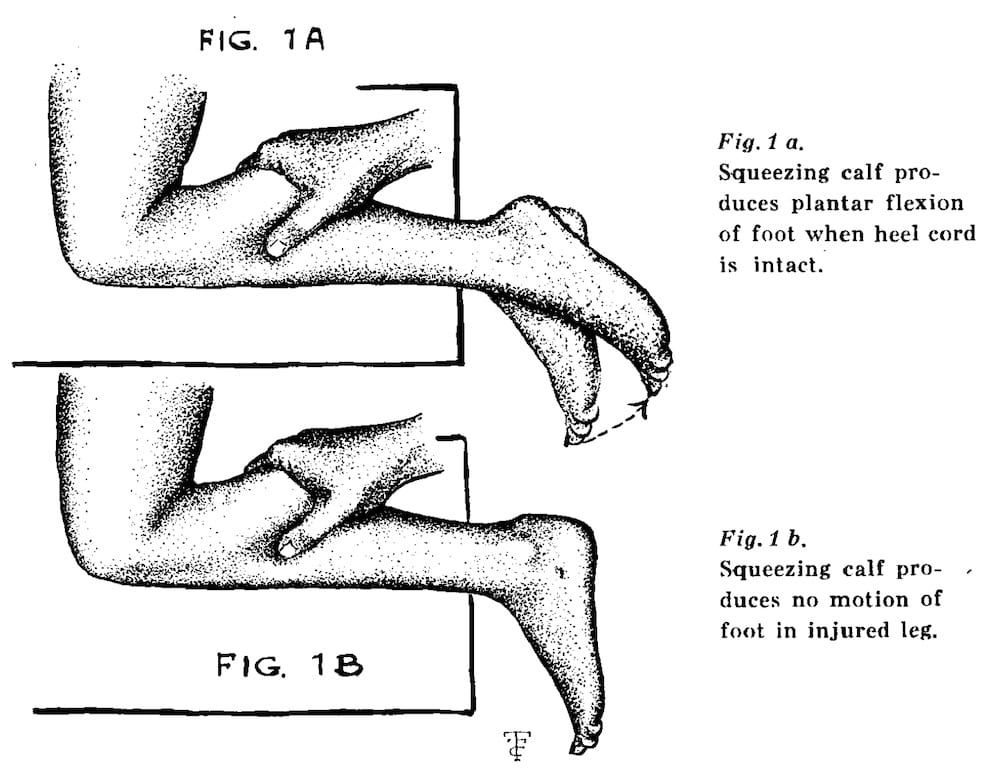Simmonds-Thompson Test
Description
Simmonds-Thompson test is a diagnostic tool for Achilles tendon rupture. The absence of foot plantarflexion on calf compression is interpreted as a positive test result and indicative of Achilles tendon rupture
Simmonds-Thompson test result should be considered positive when the physical response to calf squeezing is aberrant and the foot fails to plantarflex owing to incongruity of the Achilles tendon, indicative of rupture
History
1957 – Sam Simmonds described a test for Achilles tendon integrity consisting of two signs:
- the injured foot is in a prone position in less equinus than the uninjured one.
- on calf compression, the injured foot fails to plantarflex
1962 – TC Thompson had observed these same findings in a patient with an acute Achilles tendon rupture in 1955. He examined cadavers and noted that calf compression in the presence of a tear of <90% of the soleus still resulted in ipsilateral foot plantar-flexion. Thompson published his findings in 1962

1990 – Copeland introduced use of the sphygmomanometer to the test. [1990 Jul; 72(4): 270–271.]
1992 – Scott and al Chalabi further detailed the mechanics of the positive Simmonds-Thompson test result showing that it was indicative of an essentially fully ruptured Achilles tendon. [JBJS 1992; 74(2): 314-5.]
Associated Persons
- Franklin Adin Simmonds (1910-1983)
- T. Campbell Thompson (1902-1986)
Alternative names
- Simmonds Test
- Thompson Test
- Calf squeeze Test
Controversies
Interestingly, debate sometimes ensues regarding whether the test is positive when the foot plantarflexes on compression of the calf or is positive when the foot fails to plantarflex. The test result should be considered positive when the physical response to calf squeezing is aberrant and the foot fails to plantarflex owing to incongruity of the Achilles tendon.
For clarity a commonly used and more pragmatic way to describe the findings is: ‘there is a presence or absence of plantar flexion with Simmonds-Thompson’
References
Historical references
- Simmonds FA. The diagnosis of the ruptured Achilles tendon. The Practitioner. 1957; 179(1069): 56-8.
- Thompson TC, Doherty JH. Spontaneous rupture of tendon of Achilles: a new clinical diagnostic test. J Trauma. 1962; 2: 126-129.
- Thompson TC. A test for rupture of the tendo achillis. Acta Orthop Scand. 1962; 32: 461-5.
Review references
- Copeland SA. Rupture of the Achilles tendon: a new clinical test. Ann R Coll Surg Engl. 1990; 72(4): 270–271.
- Somford MP, Hoornenborg D, Wiegerinck JI, Nieuwe Weme RA. Are You Positive That the Simmonds-Thompson Test Is Negative? A Historical and Biographical Review. J Foot Ankle Surg. 2016; 55(3): 682-3.
- Boyd RPR et al. Achilles tendon rupture: how to avoid missing the diagnosis. Br J Gen Pract. 2015; 65(641): 668–669.
- Scott BW, al Chalabi A. How the Simmonds-Thompson test works. J Bone Joint Surg Br. 1992;74(2):314-5.
- McKennedy C. Simmonds-Thompson Test. Eponym A Day. Instagram
- Eponymythology: Eponymous ankle and talus injuries. LITFL
[cite]
eponymictionary
the names behind the name
